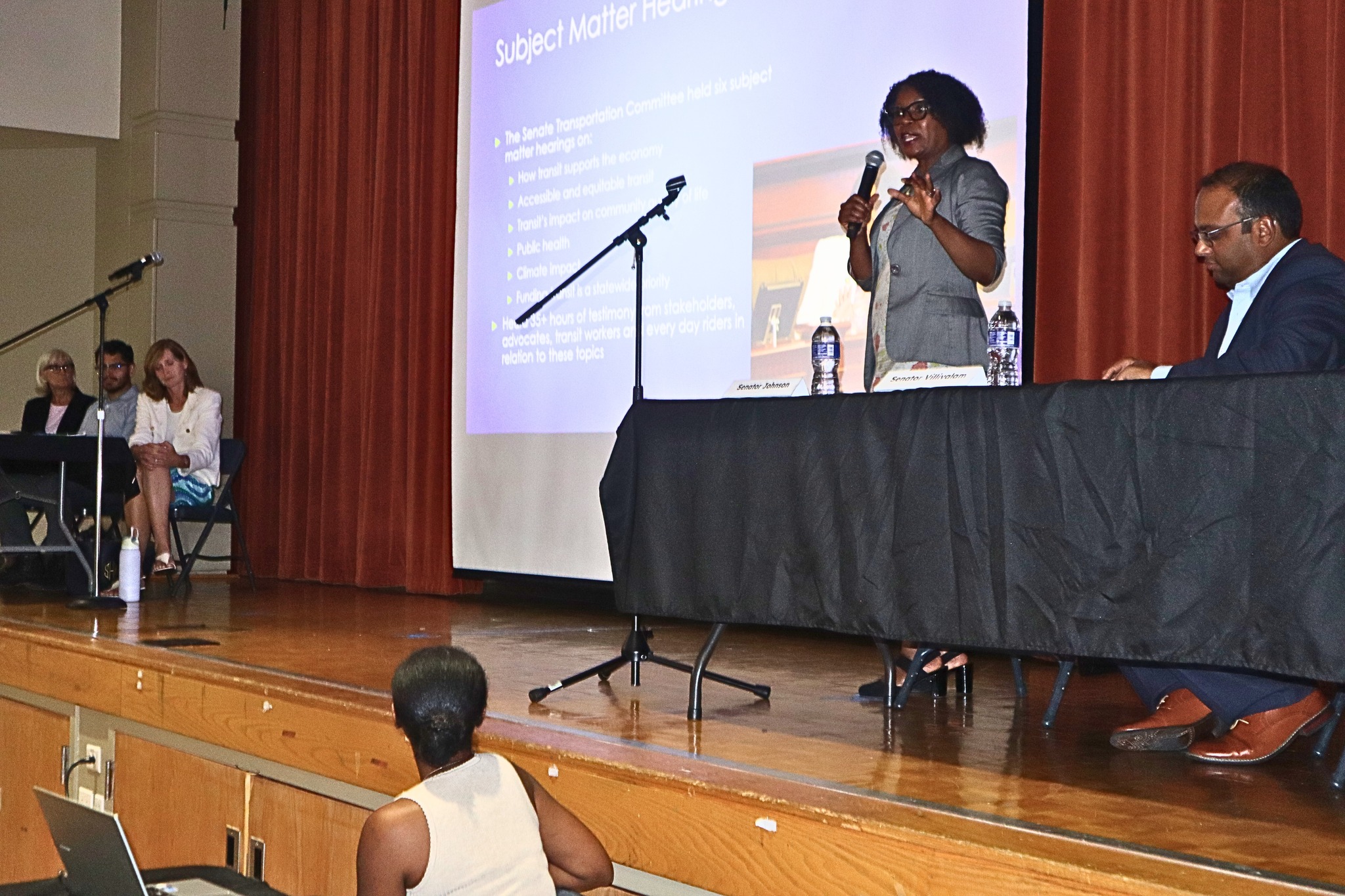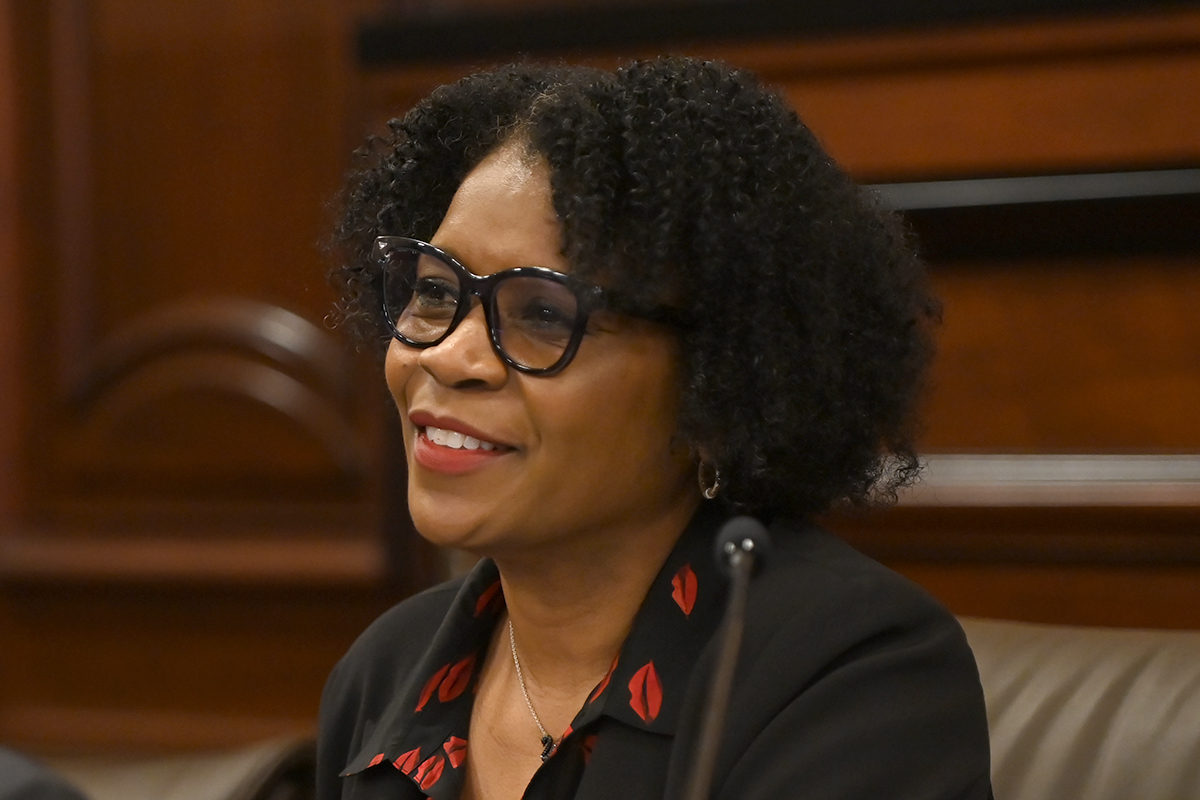
BUFFALO GROVE — Providing updates to members of the community, State Senators Adriane Johnson and Mary Edly-Allen hosted a State of Transit Town Hall last night, alongside Lake County Board Chair Sandy Hart and Senate Transportation Chair State Senator Ram Villivalam (D-Chicago).
“Last night’s conversation reinforced what we already know — public transit is more than a way to get from point A to point B, it’s a lifeline for so many in our community,” said Johnson (D-Buffalo Grove). “Hearing directly from residents about their experiences helps guide our work in Springfield as we push for solutions that make transit safer, more reliable and more accessible for everyone. I’m grateful to Senator Edly-Allen, Senator Villivalam, Chair Hart and all the neighbors who joined us to share their voices and ideas.”
The Northeastern Illinois transit region is expected to hit a $771 million fiscal cliff as federal pandemic relief funding runs out. Public transit riders are currently facing issues with the system, including delayed service, a lack of routes and limited coordination of services between providers. This presents an issue for many, as they are left without reliable transportation to reach health care appointments, jobs, school and more.
During this spring’s legislative session, Villivalam, alongside his colleagues, passed House Bill 3438 through the Senate – a comprehensive piece of legislation aimed at providing safe, reliable, affordable, accessible, coordinated and economically impactful transit through viable, long-term solutions.
The town hall provided residents with information about the upcoming fiscal cliff and its potential impacts on riders, steps the Senate has taken to move Illinois toward a world-class public transit system and what is included in House Bill 3438.
“This town hall was crucial in fulfilling my office’s mission to listen to the voices of the 31st District. We had a robust discussion on the issues important to people who depend on public transportation,” said Edly-Allen (D-Libertyville). “We must focus on the transit crisis to resolve environmental and reliability concerns. Many seniors and individuals with disabilities have reached out to my office to highlight the need for reliable and consistent paratransit and other transportation options. This town hall displayed the urgency to come up with long-term, tangible solutions.”
To learn more about House Bill 3438, click here.

SPRINGFIELD — In honor of Eddie Thomas — a man who died alone in a prison infirmary without access to hospice care — State Senator Adriane Johnson led the passage of a new law aimed at bringing dignity, transparency and compassion to end-of-life care within Illinois correctional facilities.
“Eddie’s Law is about ensuring humanity doesn’t stop at the prison gates,” said Johnson (D-Buffalo Grove). “No one, regardless of their past, should face death alone, in pain or without access to basic care. This law is a step toward a more compassionate and just correctional system.”
House Bill 2397 requires the Illinois Department of Corrections to publish an annual report detailing the availability, scope, and use of hospice and palliative care services in state correctional facilities. The report will serve as a tool to inform lawmakers, advocates and the public about the gaps in care and help drive future reforms to address them.
Hospice and palliative care programs are designed to ease pain and support individuals with serious or terminal illnesses — yet access remains rare in U.S. prisons. Nationally, fewer than 5% of correctional institutions offer formal hospice care. In Illinois, where approximately 1,000 incarcerated individuals are over the age of 55 and serving long-term sentences, the need for compassionate end-of-life services is growing.
“As our prison population ages, we have a moral responsibility to ensure people are not left to suffer in silence,” Johnson said. “This law brings overdue transparency and will guide efforts to provide humane, medically appropriate care — even in the final stages of life.”
House Bill 2397 was signed into law Friday.
SPRINGFIELD — Committed to advancing equity and dignity in financial planning, State Senator Adriane Johnson’s new law will prohibit insurers from denying or limiting final expense life insurance coverage solely due to a prior felony conviction.
“Everyone deserves the chance to care for their families, even after they’re gone,” said Johnson (D-Buffalo Grove). “This law ensures that a person’s past doesn’t disqualify them from planning for the future with dignity and compassion.”
House Bill 2425 prohibits companies that offer final expense life insurance policies from rejecting applicants, limiting their coverage or inflating their premiums solely based on a felony conviction—provided the applicant is not currently incarcerated. Final expense policies—often referred to as burial or funeral insurance—are smaller-scale, affordable forms of whole-life insurance meant to help families handle end-of-life costs, including funeral services and medical bills.
By extending existing non-discrimination protections already provided in Illinois law to cover past felony convictions, this measure continues the state’s commitment to fair treatment. Current law already bars insurers from discriminating based on disability, veteran status and other personal history factors.
“This law is a step toward meaningful reintegration,” Johnson said. “When people complete their sentences, they deserve a chance to move forward—not face a lifetime of punishment. This change offers that opportunity.”
House Bill 2425 was signed into law Friday.
SPRINGFIELD — Student teachers across Illinois will now have greater opportunities to receive compensation for their classroom contributions, thanks to a new law championed by State Senator Adriane Johnson.
“Student teachers put in long hours and shoulder real responsibilities — it’s only fair they have the option to be compensated,” said Johnson (D-Buffalo Grove). “This law brings us one step closer to a more equitable, inclusive education system where aspiring educators aren’t pushed out due to financial hardship.”
House Bill 3528 prohibits public universities from enforcing rules that bar student teachers from receiving payment during their placement. While the law does not require student teachers to be paid, it eliminates longstanding prohibitions that blocked school districts, higher education institutions and nonprofit partners from providing stipends, wages or other forms of compensation.
Under previous policies, many student teachers worked full-time without pay for an entire semester — a financial burden that often discouraged talented candidates from low-income or underrepresented backgrounds from pursuing teaching careers.
“This law is about fairness and flexibility,” Johnson said. “By removing outdated barriers, we empower schools and teacher preparation programs to offer support that better reflects the demands placed on student teachers and helps diversify our education workforce.”
House Bill 3528 was signed into law Friday.
Page 2 of 80